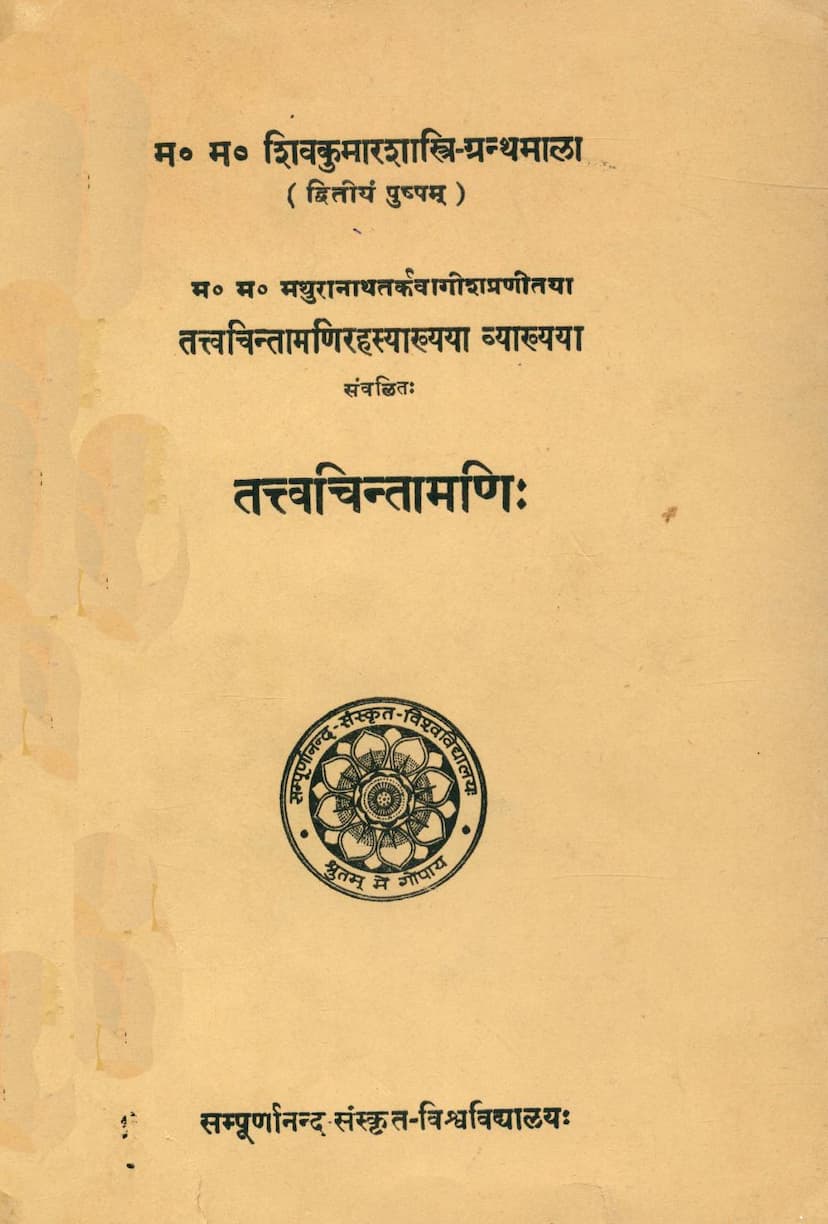Tattva Chintamani
Added to library: September 2, 2025

Summary
The provided text is a detailed catalog entry and introductory material for the book Tattva Chintamani by Gangesha Upadhyaya, with the commentary Mathuri by Mathuranatha Tarkavagisha. The edition discussed is published by Sampurnanand Sanskrit Vishva Vidyalaya in Varanasi in 1976, edited by Pt. Badrinath Shukla.
Here's a comprehensive summary in English based on the provided pages:
Book Title: Tattva Chintamani (with the Commentary Mathuri) Original Author: Gangesha Upadhyaya Commentary Author: Mathuranatha Tarkavagisha Edition Editor: Pt. Badrinath Shukla Publisher: Sampurnanand Sanskrit Vishva Vidyalaya, Varanasi Publication Year: 1976 Series: M.M. Sivakumara Sastri-Granthamala (Second Publication)
Overview:
The text presented is a publication from the Sampurnanand Sanskrit Vishva Vidyalaya, aimed at making valuable Sanskrit scholarly works accessible. This specific volume is the Tattva Chintamani, a foundational text in the Navya-Nyaya (New Logic) school of Indian philosophy, written by Gangesha Upadhyaya. It is presented with its significant commentary, Mathuri, by Mathuranatha Tarkavagisha. The edition was meticulously edited by Pt. Badrinath Shukla, former Head of the Nyaya and Vaisesika Department at the university.
Significance of Tattva Chintamani and Navya-Nyaya:
- Navya-Nyaya as a Gateway: The introductory sections emphasize that Nyaya (Logic) is one of the fourteen Vidyas (branches of knowledge) and serves as the gateway to philosophical understanding. It is considered essential for the comprehension of all other Vidyas.
- Historical Context: The text traces the development of Nyaya philosophy from the time of Gotama Muni's Nyaya Sutras, through commentaries and critiques by scholars like Vatsyayana, Uddyotakara, Vachaspati Mishra, and Udayana, and importantly, its interaction with Buddhist logicians like Dignaga and Dharmakirti. It highlights Udayana's significant role in shaping the later trajectory of Nyaya.
- Shift in Scholarly Approach: The introduction notes a significant shift in the methodology of writing philosophical texts after Udayana. Scholars moved from merely commenting on existing sutras to composing independent works, leading to more nuanced and analytical thought processes.
- Gangesha Upadhyaya and the "Chintamani" Metaphor: Gangesha Upadhyaya is presented as a pivotal figure who revolutionized Navya-Nyaya. His work, Tattva Chintamani, is described as a "gem" (Chintamani) that illuminates all other sciences through its profound insights. The title itself signifies a jewel that fulfills desires (of knowledge). The work is lauded for its comprehensive analysis and its ability to dispel the darkness of ignorance.
- Influence and Reach: The Tattva Chintamani gained immense popularity, with its light (dissemination of knowledge) spreading throughout. The text acknowledges that few other philosophical works have attracted as many extensive commentaries as the Chintamani. These commentaries, largely by scholars from Mithila, are often considered even more complex than the original text. The work's origins are traced to Mithila, its nurturing in Mithila, its growth in Bengal, and its eventual spread.
The Commentary "Mathuri":
The commentary by Mathuranatha Tarkavagisha is referred to as "Mathuri" or "Tattva Chintamani Rahasya." It is highlighted as a detailed and insightful explanation of Gangesha Upadhyaya's original work.
The Publication Project:
- Revival and Accessibility: The Sampurnanand Sanskrit Vishva Vidyalaya undertook this publication project with the aim of making the Tattva Chintamani, along with its important commentary, available to scholars and seekers of knowledge.
- Challenges and Delay: The publication faced delays due to unforeseen circumstances. While an initial plan existed in the late 19th century (1959 Vikram Samvat / 1802 CE), it couldn't be fully realized. The current publication is a result of a renewed effort.
- Editorial Efforts: Pt. Badrinath Shukla played a crucial role in editing this edition, bringing together the original text and the Mathuri commentary.
- Content of this Edition: This edition includes the Mangalavada section of the Tattva Chintamani, which deals with the philosophical discussion on auspicious beginnings. The commentary covers the initial verses, explaining the significance of invoking a deity at the commencement of a work.
Theological and Philosophical Content (Mangalavada):
The initial pages of the Tattva Chintamani (as presented in this volume) begin with Mangalavada, the discussion on the efficacy and nature of auspicious invocations.
- The Nature of Mangala (Auspiciousness): The text engages in a rigorous debate about whether mangala is truly a cause for the successful completion of an endeavor. It examines arguments related to anvayavyatireka (presence and absence), the role of tradition (shishtachara), and scriptural injunctions.
- Arguments and Counterarguments: The philosophical discussion involves dissecting the nature of causality, the role of intention, the validity of scriptural evidence, and the potential for anyatha-siddhi (alternative explanations). Various philosophical schools' views are explored and debated.
- Detailed Analysis of Causality: The text delves into the intricacies of causal relationships, the concept of apoorva (an unseen potential or merit generated by rituals), the role of obstacles (vighna) and their removal, and the ultimate aim of the endeavor (e.g., attaining salvation or fulfilling specific desires).
- The Role of Veda and Tradition: The authority of the Vedas and the practices of the learned (shishta) are central to establishing the validity and purpose of mangala. The text examines how scriptural injunctions and customary practices inform the understanding of auspicious acts.
In essence, this publication represents a significant scholarly effort to bring a critical and well-commented edition of a key Navya-Nyaya text to the academic world, focusing on the philosophical intricacies of the initial auspicious invocations.